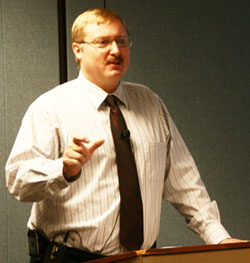|
By Laurie Gustafson

Mike Barnes, Engineering Services Division director, discusses current successes in project management during the opening session of the project management peer review. Photo by Matt Miranda
|
Project management may look different throughout the country, but Mn/DOT is tapping the best ideas from national and federal transportation agencies to make improvements.
The Office of Project Scope and Cost Management recently hosted a peer review that involved practitioners from the Arizona, Washington, Utah, Virginia and Pennsylvania departments of transportation. Representatives from the Federal Highway Administration, University of Minnesota Center for Transportation Studies and the transportation consulting firm CH2M Hill also participated.
“The peer review was designed to benchmark our success and the success of what others in the industry are doing,” said Mike Barnes, Engineering Services Division director. “Our project management is very visible to the public and this process will help as we move toward strengthening public trust.”
For four days in October, about 150 Mn/DOT employees were interviewed and participated in the review. Participants focused their discussion on four areas—project phases, functional areas, program management and initiatives and support. Peer reviewers listened to Mn/DOT staff talk about project management, but they also shared best practices from their own organizations.
“I feel honored to be here because much of what I know about project management I learned when working on a Mississippi River bridge project in St. Louis,” said George Jones, mega projects manager for the FHWA. “Although each state develops project management plans differently, the foundation for quality project management remains the same.”
In preparation for the interviews, the Office of Project Scope and Cost Management surveyed project managers, functional groups and management staff in mid-September to gather information about their processes and thoughts for improvement in project management within Mn/DOT.
“Project managers often become firefighters dealing with issues late in the process when they become a high risk,” said Mike Ginnaty, Project Scope and Cost Management director. “Good project management plans help project managers to be fire preventers and help ensure that we are managing the scope, schedule and budget of a project in addition to mitigating risks and managing commitments that we’ve made to our stakeholders.”
Recommendations and observations from the peer review will help identify opportunities for improvement and focus on creating, implementing, supporting and sustaining a stronger project management culture within Mn/DOT. A report based on the results of the project management peer review will be complete by the end of the year. In the meantime, the peer reviewers are summarizing their observations and identifying best practices and issues.
“We heard a lot of great information in the interviews,” said Jean Wallace, Project Scoping Section director. “Everyone was very open and honest about identifying both best practices and challenges.”
For more information about the peer review, contact Wallace at 651-366-3181 or Jean.Wallace@dot.state.mn.us. |



